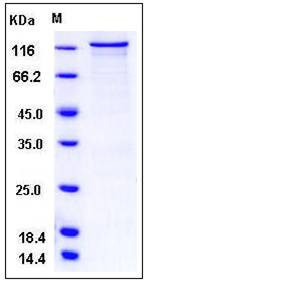Human PKC nu / PRKD3 Protein (GST Tag)
EPK2,nPKC-NU,PKC-NU,PKD3,PRKCN
- 100ug (NPP4171) Please inquiry
| Catalog Number | P10665-H09B |
|---|---|
| Organism Species | Human |
| Host | Baculovirus-Insect Cells |
| Synonyms | EPK2,nPKC-NU,PKC-NU,PKD3,PRKCN |
| Molecular Weight | The recombinant human PRKD3/GST chimera consists of 1114 amino acids and predicts a molecular mass of 126.7 kDa as estimated in SDS-PAGE under reducing conditions. |
| predicted N | Met |
| SDS-PAGE |  |
| Purity | > 85 % as determined by SDS-PAGE |
| Protein Construction | A DNA sequence encoding the full length of human PRKD3 (NP_005804.1) (Met 1-Pro 890) was expressed with the GST tag at the N-terminus. |
| Bio-activity | Kinase activity untested |
| Research Area | Signaling |Signal Transduction |Signaling Pathway |Representative pathway |Wnt Signaling pathway |Wnt Intracellular Signaling | |
| Formulation | Supplied as sterile 20mM Tris, 500mM NaCl, 10mM Reduced Glutathione, pH 7.4 1. Normally 5 % - 8 % trehalose, mannitol and 0.01% Tween80 are added as protectants before lyophilization. Specific concentrations are included in the hardcopy of COA. |
| Background | Serine/threonine-protein kinase D3, also known as Protein kinase C nu type, Protein kinase EPK2, PRKD3, EPK2 and PRKCN, is a cytoplasm and membrane protein which belongs to the protein kinase superfamily, CAMK Ser/Thr protein kinase family and PKD subfamily. PRKD3 / PRKCN contains one PH domain, two phorbol-ester/DAG-type zinc fingers and one protein kinase domain. Protein kinase C (PKC) is a family of serine- and threonine-specific protein kinases that can be activated by calcium and the second messenger diacylglycerol. PKC family members phosphorylate a wide variety of protein targets and are known to be involved in diverse cellular signaling pathways. They also serve as major receptors for phorbol esters, a class of tumor promoters. Each member of the PKC family has a specific expression profile and is believed to play a distinct role. PRKD3 / PRKCN converts transient diacylglycerol (DAG) signals into prolonged physiological effects, downstream of PKC. It is involved in resistance to oxidative stress. PRKD3 / PRKCN is activated by DAG and phorbol esters. Phorbol-ester/DAG-type domains 1 and 2 bind both DAG and phorbol ester with high affinity and mediate translocation to the cell membrane. Autophosphorylation of Ser-735 and phosphorylation of Ser-731 by PKC relieves auto-inhibition by the PH domain. PRKD3 / PRKCN can be activated rapidly by the agonists of G protein-coupled receptors. It resides in both cytoplasm and nucleus, and its nuclear accumulation is found to be dramatically enhanced in response to its activation. PRKD3 / PRKCN can also be activated after B-cell antigen receptor (BCR) engagement, which requires intact phospholipase C gamma and the involvement of other PKC family members. |
| Reference |
